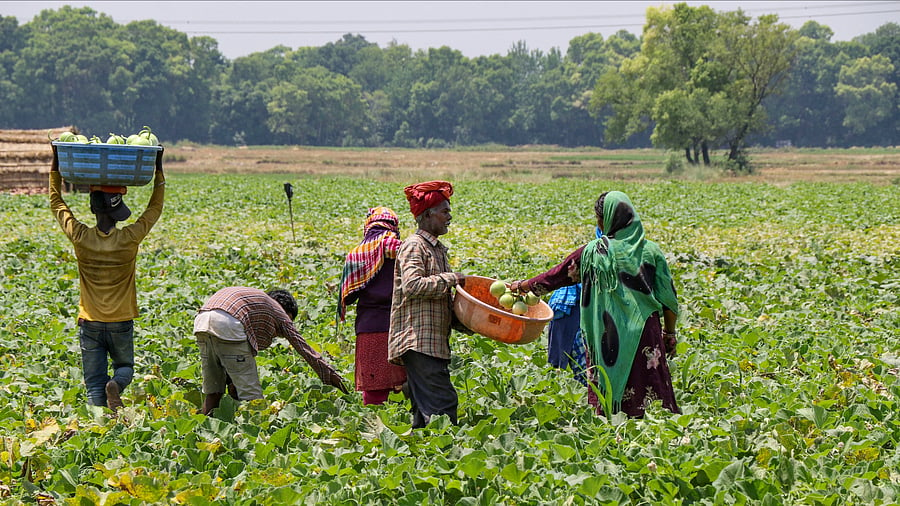
File photograph used for representational purposes only
Credit: PTI
Consumer Price Index (CPI) inflation rose to 5.69% in September from 3.65% in August, marking a phenomenal increase of 50.4%. The CPI is a widely used inflation measure that tracks changes in the prices of a basket of goods and services over time. It is based on a representative sample of prices collected monthly from retail stores, service establishments, rental units, and doctors’ offices. As of September 2024, India’s food inflation rate was 9.24%. This is a significant increase from the 5.66% in August—an increase of a staggering 63.3% in just one month.
Typically, high food prices prompt follow-up government action to unleash measures to protect consumers. There is a widespread belief among Indian consumers that high food prices mean more money in farmers’ kitty. But is this really the case? A recent investigation conducted by the Washington-based International Food Policy Research Institute, along with its subsidiary in Colombo, Sri Lanka, found that “year-on-year increases in the real price of food predict reductions in the $3.20 per day poverty headcount, except in more urban and non-agrarian countries.”
The study examined the correlation of poverty rates, real changes in food prices, and food production growth of 33 middle-income countries over two decades (2000-2019)—a period in which there were two major food price spikes globally, that is, between 2007 and 2008 and 2010 and 2011. Researchers focused on the question of whether a rise in food prices led to an increase in farmer income and others engaged in food production. The moot question is, would the findings apply to Indian conditions, in particular, at a time when food prices in India are galloping?
It is now agreed that India is facing a high food inflation surge. The important question that has to be looked into, if indeed this is so, is: what is the percentage of the consumer food price that goes back into the farmers’ kitty? The Reserve Bank of India thoroughly examined this question and found the following:
The RBI considered several items from both the livestock and agricultural sectors. In the livestock sector, they looked at poultry meat, dairy, and eggs, while in the agricultural sector (in particular vegetables), tomatoes, potatoes, and onions were considered. In the case of the livestock sector, the estimate is that 70% and 75% of what a consumer pays goes back to the dairy and egg farmers, while in the case of the poultry, it is just 56%. In the cases of tomatoes, onions, and vegetables, farmers get 33%, 36%, and 37%, respectively, of the consumers’ buying price. Hence, in two segments, namely poultry meat and vegetables, farmers do not get a decent share of the consumers’ spending. And unfortunately, the vegetable farmer is the biggest loser, as vegetables, onions, and tomatoes make up the principal diet of most Indians.
Almost always, what the vegetable farmer gets does not even cover the cost of production. Interestingly, these two segments have witnessed significant demand from customers.
Inefficient marketing systems and the absence of a well-integrated value chain are the bane of Indian agriculture. Despite high food prices and inflation, Indian farmers often receive only a small share of consumer spending. In many cases, what farmers earn does not even cover the production costs. The vegetable and poultry meat segments are an illustration of this skewed phenomenon. Interestingly, these two segments have witnessed huge demand from the consumers and corresponding sales without the farmer getting a fair deal. In the flush season, farmers are often seen discarding their produce or resorting to distress sales, while in the lean season, consumers face higher price pressures. Interestingly, this does not happen with staples like wheat or rice, where there is a “minimum price” guarantee by the central government.
The “boom and bust cycle” of the trio—tomato, onion, and potato—clearly establishes inefficiency in marketing and absence of value chain. To take a practical example from Europe, this author, while living in Europe, has observed that the cost of a kilogram of grape hardly varies while travelling from the southernmost tip of Europe, in Athens in Greece, to the northernmost tip in Oslo in Norway. But in India, a similar example can vary enormously when travelling from Delhi to Thiruvananthapuram in Kerala. This prompts the author to suggest that it is high time New Delhi thought of an “Indian Common Market” like the “European Common Market.” But will the ubiquitous “middlemen” throw a spanner in the suggestion? That, indeed, is a million-dollar question.
(The writer is a former professor, The Royal Society, Belgium)